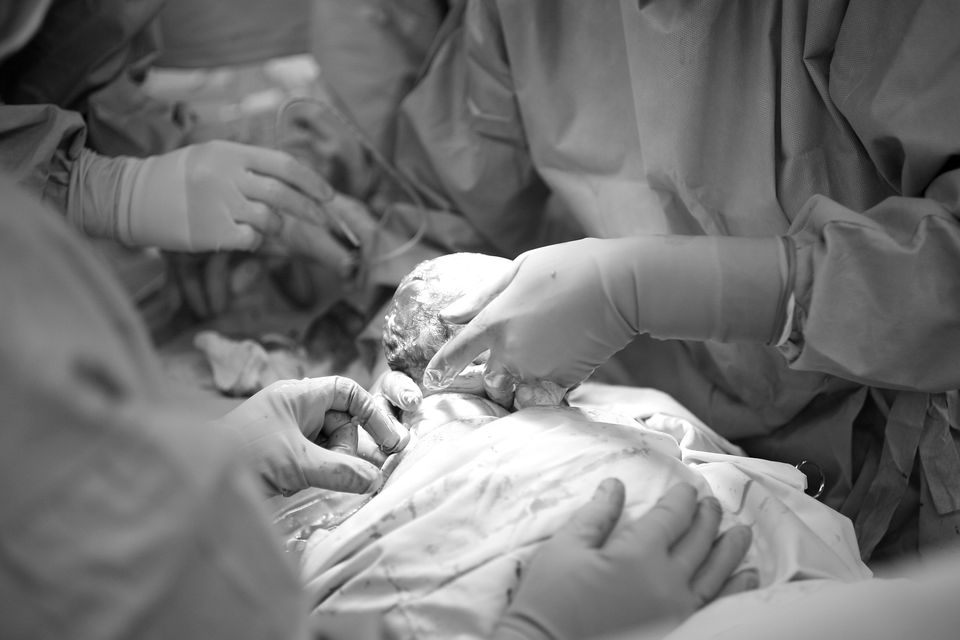Revealed: The hospitals where babies are more likely to be born by C-section as national rate hits 10-year high
Ireland has fifth-highest rate among OECD countries
Ireland has fifth-highest rate in the OECD which has an average of 28 per 100 births. Photo: Getty
More than one in three babies are now delivered by caesarean section – with even higher rates in hospitals in Kilkenny, Letterkenny, Portiuncula and Kerry, a new report reveals today.
The national rates of caesarean section per 100 live births increased from 28pc in 2012 to 36.6pc in 2021 – marking a 10-year high. Ireland now has the fifth-highest rate among the 38 Organisation for Economic Co-operation and Development (OECD) countries across which the average is 28 C-sections per 100 births.
In 2021, the rate in St Luke’s Hospital Kilkenny was 43.7 per 100 births, while it stood at 42.3 per 100 births in Portiuncula Hospital in Co Galway. It was at over 40 per 100 births in Letterkenny Hospital and University Hospital Kerry.
The statistics are set out in the report of the National Healthcare Quality Reporting System for last year which tracks trends across the health service.
It pointed out: “There was some variation observed in the rates of caesarean section per 100 live births in 2021 in maternity hospitals in Ireland.
“It should be noted that the findings presented in this report are from a high-level analysis which does not take into account a number of factors that are known to impact on caesarean section rates, including age of the mother, underlying comorbidity, history of caesarean section, multiple births, or complex presentations and pregnancies.”
Research studies into rising caesarean sections here have shown the reasons can be complex and multi-factorial.
A doctor’s fear of being sued was one of the reasons cited in a study on the increase among first-time mothers by the School of Nursing and Midwifery at Trinity College Dublin last year.
It found other factors include culture and practice in the system as well as different thresholds for intervention.
More women giving birth are now obese and this can lead to complications which result in a caesarean birth.
Older mothers are more likely to have a history of pregnancy loss or to have had treatment for infertility. They may be risk-averse because fertility levels decrease with age and their opportunities for childbirth in the future are fewer.
The report highlighted how outcomes for people admitted to hospital due to a heart attack or with a stroke diagnosis have improved significantly between 2013 and 2022.
Read more
There has been a 23pc fall in in-hospital deaths within 30 days of admission for heart attacks and a 38pc drop in in-hospital deaths within 30 days of admission from ischaemic stroke over this period.
However, there are also variations between hospitals and it shows for in-hospital deaths within 30 days of admission for haemorrhagic stroke. The rates in Mullingar, Our Lady of Lourdes and Waterford are significantly higher.
A spokesperson for the Department of Health said the in-hospital mortality rate is an important indicator of the quality of acute care for stroke patients.
In 2021, the average age-sex standardised in-hospital mortality rate with haemorrhagic stroke in Ireland was slightly above the OECD average rate – 23.2 deaths per 100 cases for Ireland compared to the OECD average of 22.9 deaths per 100 cases, though the difference was not statistically significant.
Since the development of the National Clinical Programme for Stroke in 2010, there have been significant improvements in how stroke services are delivered in Ireland and outcomes for people admitted to hospital with a stroke diagnosis have improved significantly, the spokesperson added.
The disruption to health service due to the pandemic was still being felt at the time statistics were being compiled.
It found the uptake of cervical cancer screening had climbed from 65pc in 2011 to 73pc and is still below the 80pc target.
At a county level, screening uptake rates from 2017 to 2022 ranged from 64pc in Laois to 80pc in Carlow which was the only county that achieved the 80pc target coverage for the time period.
Uptake of breast cancer screening through BreastCheck from 2012 to 2021 was above the 70pc target and it was 74.8pc in 2021. It was lowest at 68pc in Meath, 69.3pc in Longford and 69.9pc in Louth. It was 71pc in Dublin and 71.5pc in Kerry.
Take-up for bowel screening through BowelScreen remains below the target of 50pc although it reached 49.5pc in 2021.At county level, the coverage rate ranged from 7.8pc in Clare to 50.2pc in Louth. Louth was the only county that met the target rate of 50pc uptake.
The latest data from the OECD reports that Ireland’s rate of chronic benzodiazepine or tranquiliser prescription was 74.6 per 1,000 aged 65 years and older. This was significantly higher than the OECD average rate of 29.1 per 1,000.
The percentage of healthcare workers vaccinated against flu in public hospitals increased annually up to the 2020 and 2021 winter but there was a fall the following winter to 64.5pc and a further decrease to 54.4pc in the 2022 and 2023 season. The rate has remained below the national target over the last 10 flu seasons.This is despite a target of 75pc. It was highest among medical and dental staff at 69pc.It was as low as 34pc in Cavan Hospital.
Join the Irish Independent WhatsApp channel
Stay up to date with all the latest news










